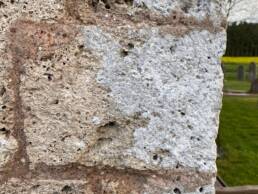Geology
Moccas Church is largely constructed from tufa which is a form of limestone which looks rather like volcanic pumice. Tufa is formed by surface water percolating through bands of limestone, thus absorbing calcium carbonate which is then redeposited as tufa, consisting of petrified moss, grass, trees and wood.

It is a light but strong stone, quarried directly from a deposit close to the church. Some blocks of sandstone are also visible on the external west wall. The sandstone was quarried at nearby Bredwardine and indeed Bredwardine Church is constructed largely from sandstone and a small amount of tufa.
Good quality sandstone was used by medieval carvers, especially at Kilpeck where the carvings have withstood the elements. Unfortunately, the tufa carvings over the doorways at Moccas are now lost, although we are fortunate to have drawings which depict them as they were during the 19th Century (more information on this can be found in the Architecture section).
Text kindly provided by Rachel Jenkins
Source Material
Payne J., (Ed) 2017 Herefordshire Rocks and Scenery : A geology of the county.
Paul and Sue Olver: personal communication.
https://www.designingbuildings.co.uk/wiki/Tufa_and_tuff